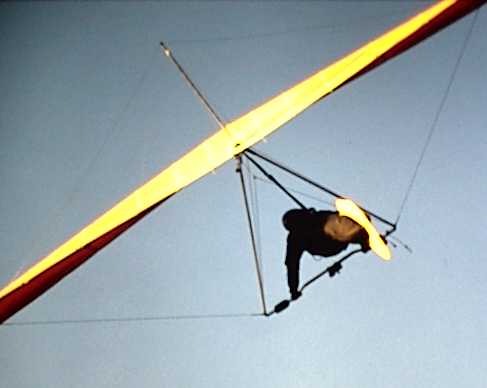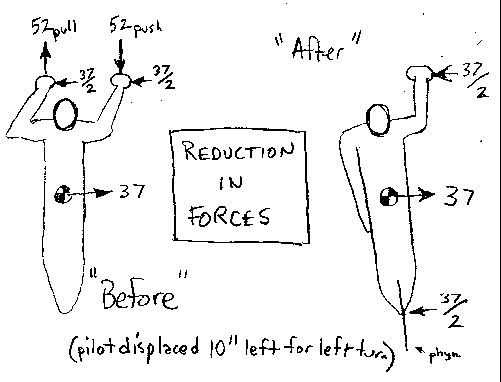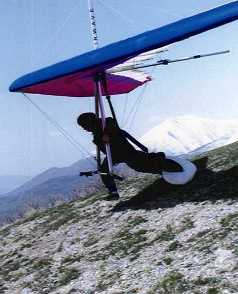
Phlying
The stabilizing effect is notoriously subtle, but definitely there. It is weak at slow speed and strong when going fast. When you let go of the bar, it does keep your body pointed straight into the wind and does not affect the harness pitch behavior. Your body's trim position is a tad farther forward relative to the glider. You and your glider behave the same as before, so at first the phyn appears to serve no useful purpose. It turns out that after many years of flying the regular way, we develop muscle memory and strong habits that are very hard to break. Thus, when the phyn is first attached, it appears to do absolutely nothing because you continue to do all the work, just like you always have. I flew around like this for nearly three years before I discovered something very cool indeed.
It was a typical good Northside day in 1998 when, out of curiosity, I decided to see if the phyn would allow me to fly using just one hand. I tucked my left hand into my pants pocket to get it out of the way. Shortly thereafter, I experienced a major epiphany. Once I had let go the notion that I was responsible for keeping myself pointed straight into the wind at all times, I submitted and allowed the phyn to do its thing. At first, it was difficult to relinquish all yaw control inputs (several times, I was very tempted to grab on with both hands), but after a while I discovered that I could indeed fly using just one hand (actually just two fingers of one hand; thumb and forefinger). However, it required using a brand new method of turning!
(To see a video clip of one handed manuvering using the PHYN II go to the
VIDEO CLIPS page!)
 Instead of translating your body sideways in the conventional manner using both hands, you simply rotate your body using just one hand to push your head in the direction you wish to go. Once your body gets a bit sideways, the wind starts acting on the phyn which pushes your tail in the direction required to straighten you out. Thus, the phyn can and will do work for you, but only if you let it. On this flight I flew for over an hour and a half with one hand, trading right and left every 20 minutes or so. This flight was a mixture of mellow thermals and ridge lift, and the VG of my PacAir K2-145 was 50% on.
Instead of translating your body sideways in the conventional manner using both hands, you simply rotate your body using just one hand to push your head in the direction you wish to go. Once your body gets a bit sideways, the wind starts acting on the phyn which pushes your tail in the direction required to straighten you out. Thus, the phyn can and will do work for you, but only if you let it. On this flight I flew for over an hour and a half with one hand, trading right and left every 20 minutes or so. This flight was a mixture of mellow thermals and ridge lift, and the VG of my PacAir K2-145 was 50% on.

It turns out that this new turning method is both natural and easy. Its natural, because you simply rotate your upper body to point your head in the direction you wish to go. It makes flying easier because there is no longer a need to spend as much energy keeping your body pointed in the wind (this workload is significant and you really only notice it once its gone. For more, see
my (rough) handwritten notes). And the stabilizing effect of the phyn makes it easier to relax while flying since you can significantly lighten up your grip on the bar. This also makes it easier to fly twitchy gliders that are very sensitive to control inputs (such as my K2). Once your grip is more relaxed, you can better sense what you and your glider are doing.
The phyn provides enhanced yaw control authority and allows you to apply a continuous yaw force to the control bar (something you couldn't do otherwise). You're feet are now "connected" to the air, giving you something solid to push against in the yaw direction. Without a phyn, the only thing you can "push against" is the rotational inertia of your body (i.e. the so called "punch turn"), which only works for a brief moment.
|